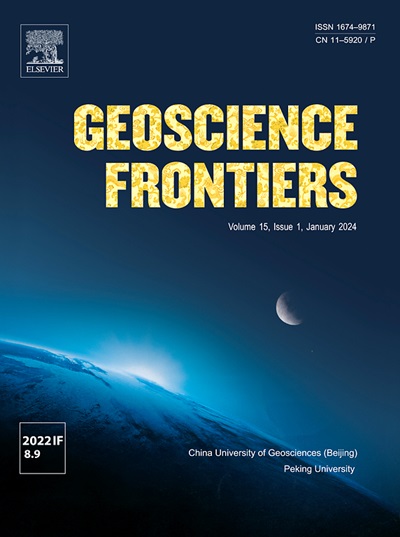Phosphorite deposits: A promising unconventional resource for rare earth elements
IF 8.9
1区 地球科学
Q1 GEOSCIENCES, MULTIDISCIPLINARY
引用次数: 0
Abstract
The green energy transition relies heavily on critical metals, such as rare earth elements (REEs). However, their reserves are primarily focused in a few countries, such as China, which accounts for approximately 70% of global production. Hence, several countries are currently looking for alternative resources for REEs. Alternative REE resources in the supply chain include recycling of e-waste, industrial waste like red mud and phosphogypsum, coal ash, mine tailings, ocean floor sediments, and even certain types of sedimentary deposits like phosphorites where REEs are present in lower concentrations but at larger volumes compared to primary ore deposits which are becoming targets by REEs industry. Currently, several studies are going on the development of eco-friendly REEs extraction technologies from phosphorite deposits. Consequently, advanced data analysis tools, such as Machine Learning (ML), are becoming increasingly important in mineral prospectivity and are rapidly gaining traction in the earth sciences. Phosphorite deposits are mainly used to manufacture fertilizers as these rocks are known for their significant phosphorus content. Moreover, these formations are considered a prospective resource of REEs. The different types of phosphorite deposits such as continental, seamount, and ore deposits worldwide reported concentrations of ∑REE upto 18,000 µg/g. Due to the augmented claim of REEs for various ultra-modern, and green technology applications that are required to switch over to a carbon–neutral environment, these phosphorite deposits have become an important target mostly because of their relatively higher content of REEs especially heavy rare earth elements (HREE). For example, Mississippian phosphorites reported ∑HREE 7,000 µg/g. To have a comprehensive understanding of the REEs potential of these phosphorite deposits which also include several Chinese phosphorite deposits, this study is undertaken to review the phosphorite deposits in the world and their REEs potential, in addition to some of the associated aspects such as applications and formation mechanisms for different types of phosphorite deposits such as igneous phosphate deposits, sedimentary phosphorite deposits, marine phosphorite deposits, cave phosphate deposits, and insular guano deposits. Other important aspects include their occurrences, types, geochemical characteristics, the REEs enrichment mechanisms, and various recovery methods adopted to recover REEs from different phosphorite deposits. The present review paper concludes that the recent studies highlight the global potential of phosphorite deposits to satisfy the increasing demand for REEs. Extracting REEs from phosphorite presents no significant technological or environmental difficulties, as long as radioactive elements are eliminated. In India, more comprehensive geological surveys, along with the advancement of new methods and evaluations, are required to locate phosphorite deposits with high concentrations of REEs.

磷矿矿床:稀土元素的一种有前途的非常规资源
绿色能源转型严重依赖关键金属,如稀土元素(ree)。然而,它们的储量主要集中在少数几个国家,比如占全球产量约70%的中国。因此,一些国家目前正在寻找稀土元素的替代资源。供应链中的替代稀土资源包括回收电子废物、工业废物(如赤泥和磷石膏)、煤灰、矿山尾矿、海底沉积物,甚至某些类型的沉积矿床(如磷矿),其中稀土的浓度较低,但与成为稀土工业目标的原生矿床相比,储量较大。目前,从磷矿沉积物中提取环保型稀土元素的研究正在进行。因此,先进的数据分析工具,如机器学习(ML),在矿产勘探中变得越来越重要,并迅速在地球科学中获得牵引力。磷矿沉积物主要用于制造肥料,因为这些岩石以其显著的磷含量而闻名。此外,这些地层被认为是稀土元素的远景资源。据报道,世界各地不同类型的磷矿床(如陆相、海山和矿床)的∑REE浓度高达18000µg/g。由于各种超现代和绿色技术应用需要转换到碳中性环境,这些磷矿矿床已成为一个重要的目标,主要是因为它们的稀土含量相对较高,特别是重稀土元素(HREE)。例如,密西西比系磷质岩的∑HREE为7000µg/g。为了全面了解这些磷矿床(包括中国的几个磷矿床)的稀土资源潜力,本文对世界磷矿床及其稀土资源潜力进行了综述,并对火成岩磷矿床、沉积磷矿床、海相磷矿床等不同类型磷矿床的应用和形成机制等方面进行了研究。溶洞磷矿和岛状鸟粪矿。其他重要方面包括它们的赋存状态、类型、地球化学特征、稀土富集机制以及从不同磷矿中回收稀土的各种方法。本文的结论是,最近的研究突出了全球磷矿矿床的潜力,以满足日益增长的稀土需求。只要消除放射性元素,从磷矿中提取稀土就不会出现重大的技术或环境困难。在印度,需要进行更全面的地质调查,同时采用新的方法和评价,以确定稀土元素浓度高的磷矿矿床。
本文章由计算机程序翻译,如有差异,请以英文原文为准。
求助全文
约1分钟内获得全文
求助全文
来源期刊

Geoscience frontiers
Earth and Planetary Sciences-General Earth and Planetary Sciences
CiteScore
17.80
自引率
3.40%
发文量
147
审稿时长
35 days
期刊介绍:
Geoscience Frontiers (GSF) is the Journal of China University of Geosciences (Beijing) and Peking University. It publishes peer-reviewed research articles and reviews in interdisciplinary fields of Earth and Planetary Sciences. GSF covers various research areas including petrology and geochemistry, lithospheric architecture and mantle dynamics, global tectonics, economic geology and fuel exploration, geophysics, stratigraphy and paleontology, environmental and engineering geology, astrogeology, and the nexus of resources-energy-emissions-climate under Sustainable Development Goals. The journal aims to bridge innovative, provocative, and challenging concepts and models in these fields, providing insights on correlations and evolution.
 求助内容:
求助内容: 应助结果提醒方式:
应助结果提醒方式:


